




Bathroom safety can be an important part of living on your own. It’s hard to get away from the fact that you have less space and more obstacles in the bathroom. Whether you are adapting to bathroom safety aids for the first time, or simply want a checklist of items to make your bathroom safer, here are 5 items that will help you stay safe.
Shower stools, benches and chairs allow bathers to remain seated while showering and help reduce the risk of falls.
Knock-down bath seats are easily disassembled for intermittent use. Wall-mounted seats fold against the wall for occasional use but provide only minimal support while showering.
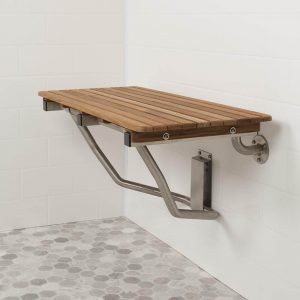
PVC and composite materials resist corrosion and are easy to clean. Non-slip feet prevent the seat from sliding in the tub or shower. Hand held shower heads are recommended when bathers are seated, especially when a caregiver provides assistance.
Adjustable height shower chairs are important for short individuals so that their feet can touch the floor while seated. Armrests and backs are helpful for people with poor balance who need additional support.
Removable arms are useful when slide boards are used for transferring to and from a wheelchair. Openings in the seat make it easier to clean intimate areas while showering.
The weight capacity varies by make and model, and should never be exceeded for safety reasons. It is important to measure bathroom doors and spaces because bariatric shower chairs may be too large to fit inside standard shower stalls.
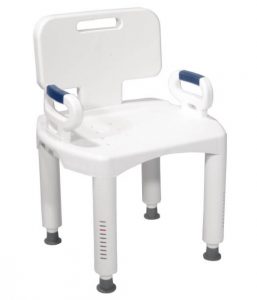
Multi-purpose shower chairs can function as commodes for individuals with very limited mobility. They are manufactured with water-resistant materials unlike typical bedside commodes.
Some shower chairs have wheels with locking casters for bringing bathers to and from walk-in shower areas. They can also be positioned over the toilet and moved to the shower while the bather stays seated. Swing-away footrests and removable arms facilitate easy transfer from the wheelchair or bed.
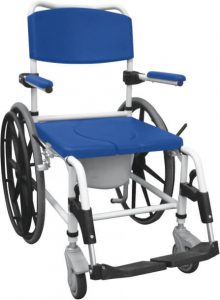
Transfer benches are longer than standard shower chairs and are designed specifically to help people with limited mobility to get in and out of the tub.
The bather can sit down outside the tub and easily slide across the bench into the tub to remain seated for showering. Normal shower chairs are stationary and can be placed inside or outside the tub but they will not aid the user with transitioning from one side of the tub to the other.
Dual-function transfer benches can also serve as commodes for people with very limited mobility.
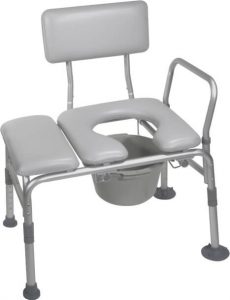
Non-slip feet are essential to prevent movement of the bench in the bathtub. Some models have sliding seats with safety belts for people with delicate skin or who need additional support.
Curtain guard protection helps prevent water from splashing onto the floor outside the tub. Many shower transfer benches have removable backs that can be switched to the other side for alternate direction use. Some models fold flat for storage, making them ideal for intermittent use.
PVC and composite materials resist corrosion and are easy to clean. The weight capacity varies by make and model, and should never be exceeded for safety reasons.

Bathtub lifts allow people who suffer from limited mobility the chance to safely enjoy the benefits of a relaxing bath. It is important to measure the bathtub before purchase even though most lifts are designed to fit standard sized tubs.
Some lifts are specially designed to accommodate small bathrooms or deeper whirlpool-style bathtubs. Lifts may have swivel seats or flaps on either side of the seat to facilitate slide transfers from a wheelchair.
A reclining seat back is important for relaxation and comfort. Most lifts have long lasting batteries with remotes that allow bathers to move the seat without risk of electrical shock.
Remote controls should float so that they will not be lost underwater. Bath lifts are held in place with suction cups for easy installation and stability in the tub during use. Some lifts can be folded for storage when not in use.
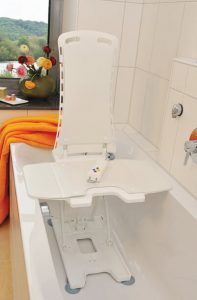
Wall-mounted safety grab bars should be installed in bathtub and shower areas to prevent slipping on wet floor surfaces. Vertical grab bars should be mounted next to the shower door jamb and on the wall next to the water controls.
Two more horizontal or diagonal grab bars should be mounted within the shower stall on the back and/or side walls. Horizontal grab bars should be installed near the rims of free-standing bathtubs and on the back wall of tub enclosures.
A grab bar should be within reach for someone seated on a bench in the tub or shower. Safety grab bars must always be mounted into wall studs to ensure that they will securely support the bather’s body weight.

Safety handles can be clamped to the side of the bathtub wall for extra support when stepping in and out of the tub. Bathtub safety handles may become loose and need to be re-tightened periodically.
They should be checked before each use that they are secure. Molded fiberglass tubs and showers are not strong enough for mounted grab bars and safety handles due to their thin materials and uneven surface designs.
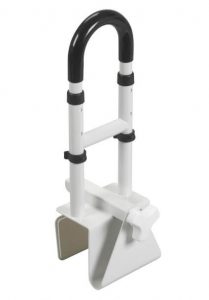
Hand-held shower heads are beneficial for people who remain seated in the shower, especially when caregivers provide assistance. The hose should be at least six feet in length to easily reach all areas of the body.
An on-off flow switch helps prevent overspray and allows the user to turn the water on and off without having to reach for the wall controls. A diverter valve allows the user to switch water flow from the wall mounted shower head to the hand-held shower spray with the flick of a switch.
A shower arm mount allows use as a traditional shower head when not needed as a hand-held sprayer. Massaging spray options help relieve pain and easily rinse shampoo from thick hair.
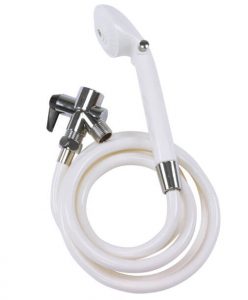
Bathroom safety is very important as it is a unique condition and not generally something we consider for ourselves. Whether you are adapting to bathroom safety aids for the first time, or simply want a checklist of items to make your bathroom safer, we hope our guide was able to help.
At HomeCare Hospital Beds we want to help you make an informed decision.
If you have any doubts on which bathroom safety aid is fit for you, please contact our HomeCare Hospital Beds team, so we can help you make the right choice.
Call us today toll free at 877-414-0002 or email us at info@homecarehospitalbeds.com.
Learn more about Hospital Bed Safety.
Read our latest Hospital Bed Buying Guide.




| Cookie | Duration | Description |
|---|---|---|
| cookielawinfo-checkbox-analytics | 11 months | This cookie is set by GDPR Cookie Consent plugin. The cookie is used to store the user consent for the cookies in the category "Analytics". |
| cookielawinfo-checkbox-functional | 11 months | The cookie is set by GDPR cookie consent to record the user consent for the cookies in the category "Functional". |
| cookielawinfo-checkbox-necessary | 11 months | This cookie is set by GDPR Cookie Consent plugin. The cookies is used to store the user consent for the cookies in the category "Necessary". |
| cookielawinfo-checkbox-others | 11 months | This cookie is set by GDPR Cookie Consent plugin. The cookie is used to store the user consent for the cookies in the category "Other. |
| cookielawinfo-checkbox-performance | 11 months | This cookie is set by GDPR Cookie Consent plugin. The cookie is used to store the user consent for the cookies in the category "Performance". |
| viewed_cookie_policy | 11 months | The cookie is set by the GDPR Cookie Consent plugin and is used to store whether or not user has consented to the use of cookies. It does not store any personal data. |